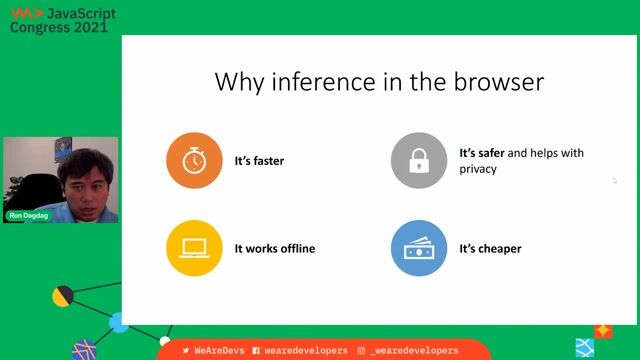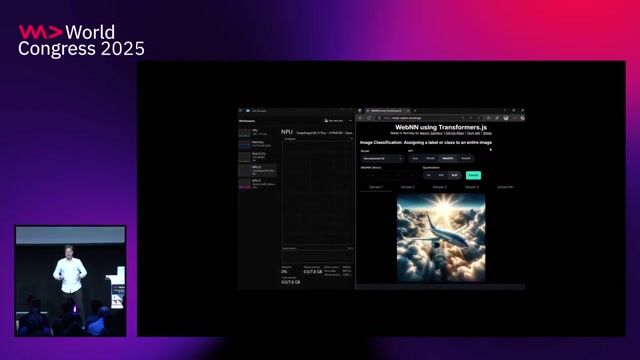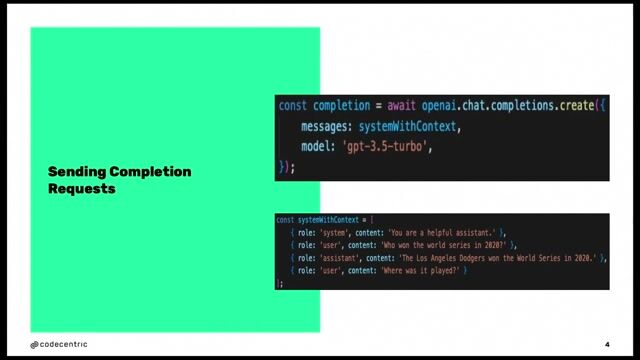Christian Liebel
Prompt API & WebNN: The AI Revolution Right in Your Browser
#1about 3 minutes
The case for running AI models locally
Cloud-based AI has drawbacks like offline limitations, capacity issues, data privacy concerns, and subscription costs, creating an opportunity for local, on-device models.
#2about 2 minutes
Two primary approaches for browser-based AI
The W3C is exploring two main approaches for on-device AI: "Bring Your Own AI" libraries like WebLLM and low-level APIs like WebNN, alongside experimental "Built-in AI" APIs like the Prompt API.
#3about 3 minutes
Running large language models with WebLLM
The WebLLM library uses WebGPU to download and run open-weight large language models directly in the browser's cache storage, enabling offline chat and data processing.
#4about 1 minute
Solving the model size and storage problem
Large AI models create a storage problem due to browser origin isolation, leading to a proposal for a Cross Origin Storage API to allow models to be shared across different websites.
#5about 2 minutes
Exploring diverse ML workloads with Transformers.js
The Transformers.js library enables various on-device machine learning tasks beyond text generation, such as computer vision and audio processing, as shown in a sketch recognition game.
#6about 4 minutes
Accelerating performance with the WebNN API
The upcoming Web Neural Network (WebNN) API provides direct access to specialized hardware like NPUs, offering a significant performance increase for ML tasks compared to CPU or GPU processing.
#7about 3 minutes
The alternative: Built-in AI and the Prompt API
Google Chrome's experimental built-in AI initiative solves model sharing and performance issues by providing standardized APIs that use a single, browser-managed model like Gemini Nano.
#8about 4 minutes
Exploring the built-in AI API suite
A demonstration of the built-in AI APIs shows how to use the summarizer, language detector, and Prompt API for general LLM tasks directly from JavaScript in the browser.
#9about 4 minutes
Practical use cases for on-device AI
On-device AI can enhance web applications with features like an offline-capable chatbot in an Angular app or a smart form filler that automatically categorizes and inputs user data.
#10about 3 minutes
Building real-time conversational agents
Demonstrations of a multimodal insurance form assistant and a simple on-device conversational agent highlight the potential for creating interactive, real-time user experiences with local AI.
#11about 1 minute
Weighing the pros and cons of on-device AI
On-device AI offers significant advantages in privacy, availability, and cost, but developers must consider the trade-offs in model capability, response quality, and system requirements compared to cloud solutions.
Related jobs
Jobs that call for the skills explored in this talk.
Matching moments

31:13 MIN
Running on-device AI in the browser with Gemini Nano
Exploring Google Gemini and Generative AI

23:20 MIN
The future of on-device AI hardware and APIs
From ML to LLM: On-device AI in the Browser

33:57 MIN
Implementing on-device AI with the Chrome AI API
WeAreDevelopers LIVE – AI vs the Web & AI in Browsers

09:43 MIN
The technical challenges of running LLMs in browsers
From ML to LLM: On-device AI in the Browser

09:04 MIN
Standardizing web AI APIs across different browsers
Exploring the Future of Web AI with Google

33:35 MIN
Performing inference in the browser with ONNX Runtime Web
Making neural networks portable with ONNX

29:19 MIN
Connecting web apps to local OS-level AI models
Exploring the Future of Web AI with Google

09:55 MIN
Shifting from traditional code to AI-powered logic
WWC24 - Ankit Patel - Unlocking the Future Breakthrough Application Performance and Capabilities with NVIDIA
Featured Partners
Related Videos
 32:27
32:27Generative AI power on the web: making web apps smarter with WebGPU and WebNN
Christian Liebel
 30:13
30:13Privacy-first in-browser Generative AI web apps: offline-ready, future-proof, standards-based
Maxim Salnikov
 27:23
27:23From ML to LLM: On-device AI in the Browser
Nico Martin
 33:51
33:51Exploring the Future of Web AI with Google
Thomas Steiner
 25:47
25:47Performant Architecture for a Fast Gen AI User Experience
Nathaniel Okenwa
 25:17
25:17AI: Superhero or Supervillain? How and Why with Scott Hanselman
Scott Hanselman
 32:26
32:26Bringing the power of AI to your application.
Krzysztof Cieślak
 31:12
31:12Using LLMs in your Product
Daniel Töws
From learning to earning
Jobs that call for the skills explored in this talk.

Senior AI Software Developer & Mentor
Dynatrace
Linz, Austria
Senior
Java
TypeScript
AI Frameworks
Agile Methodologies
![Senior Software Engineer [TypeScript] (Prisma Postgres)](https://wearedevelopers.imgix.net/company/283ba9dbbab3649de02b9b49e6284fd9/cover/oKWz2s90Z218LE8pFthP.png?w=400&ar=3.55&fit=crop&crop=entropy&auto=compress,format)
Senior Software Engineer [TypeScript] (Prisma Postgres)
Prisma
Remote
Senior
Node.js
TypeScript
PostgreSQL






